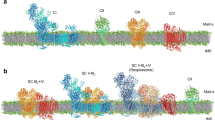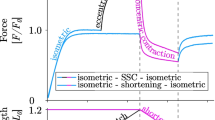Abstract
Cd2+, a serious environmental pollutant in certain industrial regions, accumulates in mammalian tissues with a very slow turnover. Using various criteria, we studied the ability of Cd2+ to substitute for Ca2+ in calmodulin (CaM), a ubiquitious Ca2+-binding protein that mediates many of the Ca2+ effects. CaM bound Cd2+ with a Kd of 4.5 μM, presumably to the Ca2+-binding sites. Binding of Cd2+ allowed CaM to bind 2 moles chlorpromazine, or to form a complex with skeletal muscle troponin-I, troponin-T, or phosphodiesterase. Complex formation with phosphodiesterase led to its activation, which was observed even in the presence of glutathione or cysteine, agents known to chelate Cd2+. This raises the possibility that one manifestation of Cd2+ toxicity may be through its activation of CaM, thus upsetting its normal regulation by a cellular flux of Ca2+.
Similar content being viewed by others
References
Amphlett GW, Vanaman TC, Perry SV (1976) Effect of the troponin C-like protein from bovine brain (brain modulator protein) on the Mg2+-stimulated ATPase of skeletal muscle actomyosin. FEBS Lett 72: 163–168
Chamness GC, McGuire WL (1975) Scatchard plots: Common errors in correction and interpretation. Steroids 26: 538–542
Chao SH, Suzuki Y, Zysk JR, Cheung WY (1984) Activation of calmodulin by various metal cations as a function of ionic radius. Mol Pharmacol 26: 75–82
Cheung WY (1971) Cyclic 3',5'-nucleotide phosphodiesterase. Evidence for and properties of a protein activator. J Biol Chem 246: 2859–2869
Cheung WY (1980) Calmodulin plays a pivotal role in cellular regulation. Science 207: 19–27
Cox JL, Harrison Jr SD (1983) Correlation of metal toxicity with in vitro calmodulin inhibition. Biochem Biophys Res Commun 115: 106–111
Ebashi S (1974) Lipmann Symposium: Energy, Regulation and Biosynthesis in Molecular Biology. (D Richter, ed) Walter de Gruyter, Berlin-New York, pp 165–178
Ebashi S, Wakabayashi T, Ebashi F (1971) Troponin and its components. J Biochem (Tokyo) 69: 441–445
Friberg L, Piscator M, Nordberg GF, Kjellstrom T (1974) Cadmium in the Environment, Ed. 2 CRC Press, Cleveland
Giles W, Hume JR, Shibata EF (1983) Presynaptic and postsynaptic action of cadmium in cardiac muscle. Fed Proc 2994–2997
Gopalakrishna R, Anderson WB (1982) Ca2+-induced hydrophobic site on calmodulin: Application for purification of calmodulin by phenyl-Sepharose affinity chromatography. Biochem Biophys Res Commun 104: 830–836
Grand RJA, Perry SV, Weeks RA (1979) Troponin C-like proteins (calmodulins) from mammalian smooth muscle and other tissues. Biochem J 177: 521–529
Hanlon DP, Watt DS, Westhead EW (1966) The interaction of divalent metal ions with Tris buffer in dilute solution. Anal Biochem 16: 225–233
Hummel JP, Dreyer WJ (1962) Measurement of protein-binding phenomena by gel filtration. Biochim Biophys Acta 63: 530–532
Jacobson KB, Turner JE (1980) The interaction of cadmium and certain other metal ions with proteins and nucleic acids. Toxicology 16: 1–37
Klee CB, Vanaman TC (1982) Calmodulin. Adv Protein Chem 35: 213–321
Kosower NS, Kosower EM (1978) The glutathione status of cells. Int Rev Cytol 54: 109–160
LaPorte DC, Toscano Jr WA, Storm DR (1979) Cross-linking of iodine-125-labeled, calcium-dependent regulatory protein to the Ca2+ sensitive phosphodiesterase purified from bovine heart. Biochemistry 18: 2820–2825
Levin RM, Weiss B (1977) Binding of trifluoperazine to the calcium-dependent activator of cyclic nucleotide phosphodiesterase. Mol Pharmacol 13: 690–697
Levin RM, Weiss B (1979) Selective binding of antipsychotics and other psychoactive agents to the calcium-dependent activator of cyclic nucleotide phosphodiesterase. J Pharmacol Exp Ther 208: 454–459
Lin YM, Cheung WY (1975) Cyclic 3',5'-nucleotide phosphodiesterase. A theoretical account of its anomalous kinetics in terms of multiple isozymes. Int J Biochem 6: 271–280
Lin YM, Liu YP, Cheung WY (1974) Cyclic 3',5'-nucleotide phosphodiesterase. Purification, characterization, and active form of the protein activator from bovine brain. J Biol Chem 249: 4943–4954
Lin YM, Liu YP, Cheung WY (1975) Cyclic 3',5'-nucleotide phosphodiesterase. Ca++-dependent formation of bovine brain enzyme-activator complex. FEBS Lett 49: 356–360
Lowry OH, Rosebrough NJ, Farr AL, Randall RJ (1951) Protein measurement with Folin phenol reagent. J Biol Chem 193: 265–275
Lynch TJ, Cheung WY (1975) Underestimation of cyclic 3',5'-nucleotide phosphodiesterase activity by a radioisotopic assay using an anionic-exchange resin. Anal Biochem 67: 130–138
March SC, Parikh I, Cuatrecasas P (1974) A simplified method for cyanogen bromide activation of agarose for affinity chromatography. Anal Biochem 60: 149–152
Mazzei GJ, Girald PR, Kuo JF (1984) Environmental pollutant Cd2+ biphasically and differentially regulates myosin light chain kinase and phospholipid/Ca2+-dependent protein kinase. FEBS Lett 173: 124–128
Nathanson JA, Bloom FE (1976) Heavy metals and adenosine cyclic 3',5'-monophosphate metabolism: possible relevance to heavy metal toxicity. Mol Pharmacol 12: 390–398
Newton DL, Oldewurtel MD, Krinks MH, Shiloach J, Klee CB (1984) Agonist and antagonist properties of calmodulin fragments. J Biol Chem 259: 4419–4426
Perrie WT, Perry SV (1970) An electrophoretic study of the lowmolecular weight components of myosin. Biochem J 119: 31–38
Samarawickrama GP (1979) Biological effects of cadmium in mammals. In: Webb M, (ed) The chemistry, biochemistry and biology of cadmium Elsevier/Holland Biomedical Press, Amsterdam-New York pp 341–408
Singhal RL, Merali Z, Hrdina PD (1976) Aspects of the biochemical toxicology of cadmium. Fed Proc 35: 75–80
Smoake JA, Song SY, Cheung WY (1974) Cyclic 3',5'-nucleotide phosphodiesterase. Distribution and developmental changes of the enzyme and its protein activator in mammalian tissues and cells. Biochim Biophys Acta 341: 402–411
Suzuki Y, Chao SH, Zysk JR, Cheung WY (1973) Dual effects of cadmium ion (Cd2+) on calmodulin activity. Fed Proc 42: 1085
Tanaka T, Hidaka H (1980) Hydrophobic regions function in calmodulin-enzyme(s) interactions. J Biol Chem 255: 11078–11080
Vallee BL, Ulmer DD (1972) Biochemical effects of mercury, cadmium, and lead. Ann Rev Biochem 41: 91–128
Wallace RW, Tallant EA, Cheung WY (1983) Assay of calmodulin by Ca2+-dependent phosphodiesterase. Meth Enzymol 102: 39–47
Wallace RW, Tallant EA, Dockter ME, Cheung WY (1982) Calcium-binding domains of calmodulin. Sequence of fill as determined with terbium luminescence. J Biol Chem 257: 1845–1854
Author information
Authors and Affiliations
Additional information
This work was supported by grants CA 21765, NS 08059 and GM 28178 from the NIH and by American Lebanese Syrian Associated Charities. J. R. Z. was a recipient of a National Research Service Award, CA 09346, USA
Rights and permissions
About this article
Cite this article
Suzuki, Y., Chao, SH., Zysk, J.R. et al. Stimulation of calmodulin by cadmium ion. Arch Toxicol 57, 205–211 (1985). https://doi.org/10.1007/BF00290889
Received:
Accepted:
Issue Date:
DOI: https://doi.org/10.1007/BF00290889




